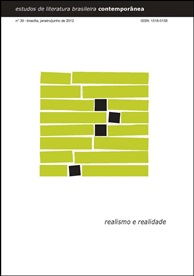De bois e outros bichos:
nuances do novo Realismo brasileiro
DOI:
https://doi.org/10.1590/S2316-40182012000100003Abstract
O texto interpreta dois contos de Marçal Aquino, "Boi" e "A exata distância da vulva ao coração", publicados em duas coletâneas diferentes, procurando verifi car como o Realismo aí representa em profundidade as relações tensionadas entre o social e o fi ccional. Revisitando gêneros tradicionais como a tragédia e o melodrama, de modo a acomodá-los à s exigências mercantis da indústria da cultura, o autor explora o tema da violência urbana brasileira, nas suas manifestações concretas e simbólicas.
Downloads
References
ADORNO, T. W. e HORKHEIMER, M. (1986). “A indústria cultural como mistifi cação das massas”. In: ______. Dialética do esclarecimento. Rio de Janeiro: Jorge Zahar.
AQUINO, Marçal (2003). Famílias terrivelmente felizes. São Paulo: Cosac & Naify.
_______ (2005). “A exata distância da vulva ao coração”. In: NESTROVSKI, Arthur. Aquela canção. São Paulo: Publifolha.
BARTHES, Roland (1984). “O efeito de real”. In: ______ et al. (Orgs.). Literatura e realidade: que é o realismo? Lisboa: Publicações D. Quixote.
BARTHES, R. et al. (1984). Literatura e realidade: que é o realismo? Lisboa: Publicações D. Quixote.
BOURDIEU, Pierre (2004). O poder simbólico. Rio de Janeiro: Bertrand Brasil.
BROOKS, Peter (1985). The melodramatic imagination: melodrama and the mode of excess. Nova York: Columbia University Press.
CARVALHO, M. Alice R. (2000). “Violência no Rio de Janeiro: uma reflexão política”. In: PEREIRA, Carlos Alberto M. et al. (Org.). Linguagens da violência. Rio de Janeiro: Rocco.
EAGLETON, Terry (2003). Sweet violence: the idea of the tragic. Oxford: Blackwell Publishing.
EL FAR, Alessandra (2005). Páginas de sensação. São Paulo: Companhia das Letras.
FRYE, Northrop (s.d.). Anatomia da crítica. São Paulo: Cultrix.
HOBBES, Thomas M. Leviatã (1974). In: Os Pensadores. São Paulo: Abril Cultural. v. 1.
LINS, Ronaldo Lima (1990). Violência e literatura. Rio de Janeiro: Tempo Brasileiro.
LUKÁCS, Georg (s.d.). Teoria do romance. Lisboa: Editorial Presença.
MEYER, Marlyse (1996). Folhetim: uma história. São Paulo: Companhia das Letras.
NESTROVSKI, Arthur (Org.) (2005). Aquela canção. São Paulo: Publifolha.
PELLEGRINI, Tânia (1999). A imagem e a letra: aspectos da ficção brasileira contemporânea. Campinas: Mercado de Letras/Fapesp.
______ (2008). Despropósitos: estudos de ficção brasileira contemporânea. São Paulo: Annablume/Fapesp.
______ (2009). “Realismo: a persistência de um mundo hostil”. Revista Brasileira de Literatura Comparada. n. 14, p. 11-46.
PEREIRA, Carlos Alberto M. et al. (Org.) (2000). Linguagens da violência. Rio de Janeiro: Rocco.
RESENDE, Beatriz (2008). Contemporâneos: expressões da literatura brasileira no século XXI. Rio de Janeiro: Casa da Palavra.
XAVIER, Ismail (2003). O olhar e a cena. São Paulo: Cosac & Naify.
WILLIAMS, Raymond (2000). Cultura. Rio de Janeiro: Paz e Terra.
Downloads
Published
How to Cite
Issue
Section
License
Authors who publish in this journal agree to the following terms:
a) The authors maintain the copyright and grant the journal the right of first publication, the work being simultaneously licensed under the Creative Commons Attribution License-Non Commercial 4.0 which allows the sharing of the work with acknowledgment of the authorship of the work and publication this journal.
b) Authors are authorized to enter into additional contracts separately, for non-exclusive distribution of the version of the work published in this journal (eg publish in institutional repository or as a book chapter), with authorship recognition and publication in this journal.
c) Authors are allowed and encouraged to publish and distribute their work online (eg in institutional repositories or on their personal page) after the editorial process, as this can generate productive changes, as well as increase the impact and citation of published work (See The Effect of Free Access).
d) The authors of the approved works authorize the magazine to, after publication, transfer its content for reproduction in content crawlers, virtual libraries and the like.
e) The authors assume that the texts submitted to the publication are of their original creation, being fully responsible for their content in the event of possible opposition by third parties.


